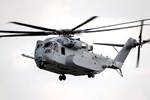Sikorsky delivers third CH-53K helicopter to U.S. Marine Corps
This is the third out of seven composites-intensive heavy-lift helicopters that have been delivered to the fleet exceeding all DOD rotary wing platforms, created in a complete, digital environment.
CH-53K heavy-lift helicopter. Photo Credit, all images: Lockheed Martin
(Stratford, Conn., U.S.), a Lockheed Martin (Bethesda, Md., U.S.) company, has delivered the third low-rate initial production (LRIP) composites-intensive CH-53K helicopter ahead of contract schedule to the U.S. Marine Corps. This aircraft, built in Sikorsky’s digital factory, is reported to be the first CH-53K from the Lot 2 LRIP contract awarded by the U.S. Navy in 2019, and the seventh overall delivered to the fleet. The CH‑53K’s heavy-lift capabilities exceed all other U.S. Department of Defense (DOD) rotary wing platforms and is the only heavy-lift helicopter that will remain in production through 2032 and beyond.
The joins the six in operation at Marine Corps Air Station New River in Jacksonville, N.C. The CH-53K is said to be the only sea-based, long-range, heavy-lift helicopter in production and will immediately provide three times the lift capability of its predecessor.
“This Connecticut-built CH-53K aircraft is a credit to our employees and their skills embracing digital tools and other advanced technologies to continue the Sikorsky legacy of building modern, safe, reliable rotorcraft. Our nationwide supply chain supports the active production line as we prepare to deliver two more CH-53K helicopters later this year,” Bill Falk, director, Sikorsky CH-53K program, says. “We look forward to continuing our progress toward next year’s full rate production decision.”
The CH-53K helicopter was , and now its digital thread connects design, manufacturing, training and sustainment teams. This network, that includes everything from work instructions to maintenance manuals, is based on the helicopter’s single, continuous data thread that stays consistent from initial design all the way through sustainment, according to Sikorsky. Today, all of Sikorsky's aircraft programs are born in a digital environment, driving affordability, producibility and reliability across the aircraft lifecycle.
The CH-53K is Sikorsky’s pioneer digital technology program with advancing installation of wheels, electrical units, hydraulics and more. The high-tech production line in Connecticut is active with seven aircraft in build on final assembly.
The CH-53K helicopters are being built at Sikorsky headquarters in Stratford, Conn., U.S., leveraging the company’s digital build and advanced technology production processes.
The U.S. Marines recently declared Initial Operational Capability (IOC) and have been flying and supporting the CH-53K in the fleet environment demonstrating the aircraft is on track to deploy on schedule in 2024. The aircraft have flown more than 3,000 flight hours showcasing the CH‑53K’s performance in a range of mission scenarios and challenging environments.
The CH-53K will support the U.S. Marine Corps in its mission to conduct expeditionary heavy-lift assault transport of armored vehicles, equipment and personnel to support distributed operations deep inland from a sea-based center of operations, critical in the Indo-Pacific region.
Earlier this year Sikorsky says it also secured a contract to build 12 CH-53K heavy-lift helicopters for Israel under a U.S. Navy Foreign Military Sales (FMS) agreement. The signed letter of offer and acceptance (LOA) between the U.S. government and Israel states first deliveries of the baseline aircraft are planned for 2025.
The CH-53K helicopters will replace the Israeli Air Force (IAF) fleet of modified CH-53D Yasur helicopters, which have been in Israel’s inventory for more than 50 years. The all-new CH-53K reportedly delivers modern state-of-the-art capabilities that result in improved survivability, safety and reduced aircrew workload over its predecessor.
Related Content
Composites end markets: Sports and recreation (2025)
The use of composite materials in high-performance sporting goods continues to grow, with new advancements including thermoplastic and sustainability-focused materials and automated processes.
Read MoreDyneema launches woven composite fabric with UHMWPE fiber
Dual-layer structure of Dyneema core with a fully woven Dyneema face fabric resists abrasion and wear, offering durability under significant load conditions and after prolonged use.
Read MoreComposites end markets: Electronics (2025)
Electronic and smart device innovations achieved through the use of advanced materials ranging from thermoplastic composites to biomaterials emphasize high-volume production and sustainability.
Read MoreRepurposing wind blades as functional community art pieces
Ohio-based Canvus Inc. upcycles fiberglass wind blades, car tires and post-consumer plastics to create outdoor furniture that amplifies sustainability messages in community spaces.
Read MoreRead Next
Albany Engineered Composites wins ten-year contract for CH-53K helicopter assemblies
Selected by Lockheed-Sikorsky, AEC will leverage its composites expertise in engine and airframe applications to meet a 2023 delivery period.
Read MoreNext-gen fan blades: Hybrid twin RTM, printed sensors, laser shock disassembly
MORPHO project demonstrates blade with 20% faster RTM cure cycle, uses AI-based monitoring for improved maintenance/life cycle management and proves laser shock disassembly for recycling.
Read MoreCeramic matrix composites: Faster, cheaper, higher temperature
New players proliferate, increasing CMC materials and manufacturing capacity, novel processes and automation to meet demand for higher part volumes and performance.
Read More












